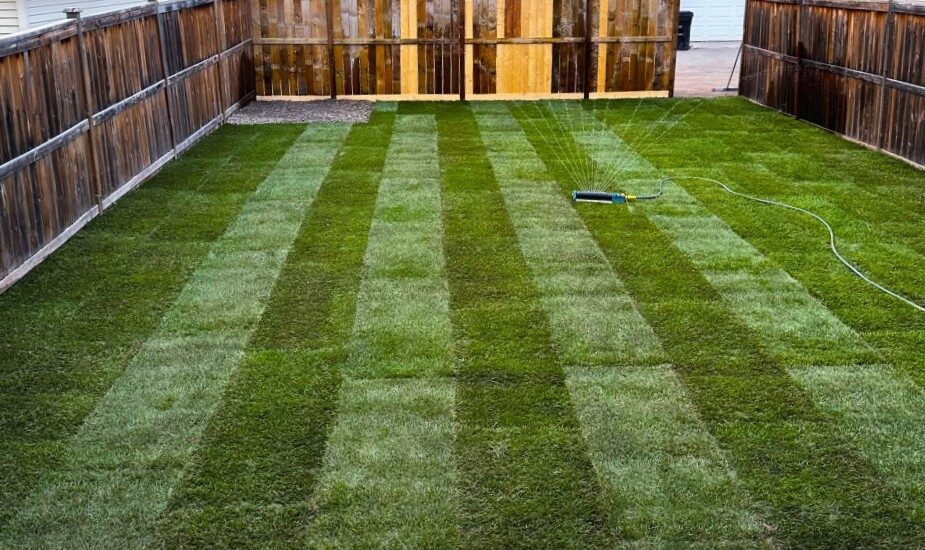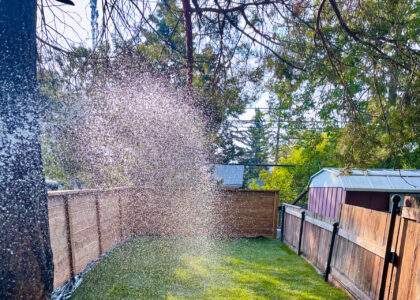When it comes to landscaping, few things transform a yard like a lush, green lawn. However, laying sod is only the first step to achieving a vibrant lawn. To ensure your sod thrives and becomes the stunning landscape centerpiece you’ve envisioned, proper care is crucial after installation.
In this blog post, we will walk you through the essential steps for taking care of your newly installed sod. Whether you’re a DIY enthusiast or a landscaping professional, following these tips will help your sod establish deep roots and grow into a healthy, long-lasting lawn. Let’s dive in!
1. Watering: The Foundation of Healthy Sod Care
Watering your sod correctly after installation is the key to helping it establish roots. Fresh sod needs consistent moisture to stay alive during its first few weeks in your yard.
Tips for proper watering:
First 2 Weeks: Water the sod thoroughly at least twice a day — early morning and late evening — to keep it moist, but not soaking.
After the First 2 Weeks: Gradually reduce watering to once a day, but ensure that the soil stays moist to a depth of 3-4 inches.
Long-term: After the roots have established, water your lawn once a week, adjusting based on the weather conditions. Avoid over-watering as it can lead to root rot.
Pro Tip: Water deeply and less frequently to encourage deeper root growth, which makes your lawn more drought-resistant in the long term.
2. Mowing: Don’t Rush, But Don’t Wait Too Long
Mowing your sod too early can stress out the grass, but waiting too long can lead to an unruly lawn. Timing is everything when it comes to mowing your new sod.
Guidelines for mowing your sod:
Wait until the grass is established: Don’t mow until your sod has rooted into the soil (typically around 2-3 weeks after installation).
Set mower height: Keep your mower blade at a higher setting (3-4 inches) to allow the sod to establish healthy roots and prevent stress.
Avoid cutting more than 1/3 of the grass height at once, as this can stress the lawn.
Pro Tip: Regular mowing every 7-10 days is essential to maintaining a healthy lawn. Avoid cutting the grass too short, as this can weaken the root system and expose the soil to weeds.
3. Fertilization: Feed Your Sod for Growth
Fertilizing is an essential step in helping your sod grow strong and vibrant. The right type and timing of fertilizer will help nourish the grass and give it the nutrients it needs to establish deep roots.
Best fertilization practices for new sod:
First Month: Apply a balanced, slow-release fertilizer that’s high in nitrogen to promote healthy growth.
3-6 Months: Use a balanced fertilizer with a slow-release formula designed for established lawns to ensure continuous growth.
Annual Fertilization: Fertilize once or twice a year, typically in the spring and fall, to keep your lawn lush and green.
Pro Tip: Be careful not to over-fertilize your sod. Too much fertilizer can burn the grass and cause more harm than good.
4. Aeration: Encourage Healthy Root Growth
Aerating your lawn can help break up compacted soil, improve water penetration, and encourage deep root growth. While it’s not necessary immediately after sod installation, once your lawn is established, aeration can be a valuable tool.
When to aerate:
After your sod has rooted, usually 6-12 months after installation, aerate the lawn to help the roots grow deeper and improve overall soil health.
Pro Tip: Aeration is best done during the growing season, in the early spring or fall, to reduce stress on the lawn.
5. Weed and Pest Control: Protect Your New Lawn
New sod is vulnerable to weeds and pests, which can hinder growth and damage the grass. It’s essential to stay vigilant and take preventive measures to keep your sod healthy and free from invaders.
Weed Control Tips:
Use pre-emergent herbicides: After your sod has rooted, apply a pre-emergent herbicide to prevent weeds from taking over.
Hand-pull weeds: Early on, you can hand-pull any weeds that pop up to keep your lawn weed-free.
Pest Control:
Look out for common pests like grubs, which can damage the sod and its roots. If you notice patches of dead or discolored grass, consult with a pest control expert for treatment.
Pro Tip: Always use eco-friendly and pet-safe products to protect your lawn and the environment.
6. Avoid Heavy Traffic on New Sod
Newly installed sod needs time to establish its root system. Limiting foot traffic during the first few weeks will give your grass the best chance to grow strong and healthy.
Pro Tip: Keep pets, children, and heavy foot traffic off the lawn until the roots have properly established (around 2-3 weeks after installation).
7. Monitor for Signs of Stress
It’s important to watch for signs that your sod might be stressed or struggling. These signs can include wilting, yellowing, or browning patches of grass.
Common causes of sod stress:
Over-watering or under-watering
Nutrient deficiency (lack of fertilization)
Pests or diseases
Pro Tip: If you notice any of these signs, take corrective action immediately by adjusting your watering schedule or consulting a professional landscaper for help.
Why Professional Landscaping Services Can Help
While taking care of sod is a rewarding experience, it can also be time-consuming and complicated. If you want to ensure the best care for your lawn without the hassle, consider working with a professional landscaping service.
At Payse Landscaping, we specialize in sod installation and maintenance. Our experienced team provides expert lawn care services, from watering and fertilization to mowing and pest control. We’re here to help you create a beautiful, healthy lawn that you can enjoy year-round.
Conclusion
Taking care of sod after installation is a crucial step to achieving the lush, green lawn you’ve always wanted. By following these essential tips and staying consistent with your lawn care, your new sod will establish strong roots and become a beautiful addition to your landscape.
Looking for professional assistance with sod installation or lawn maintenance? Contact Payse Landscape today for expert landscaping services that will help you achieve a vibrant, healthy lawn!


